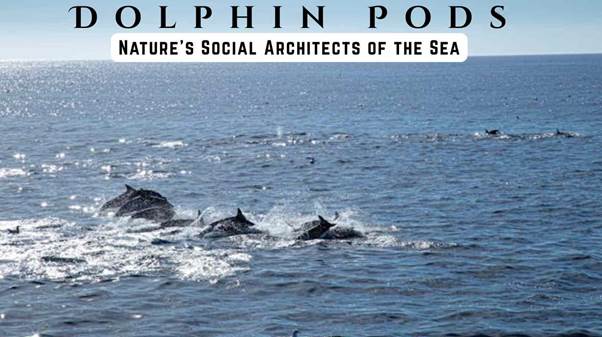The ocean is filled with wonders, and among the most captivating are dolphin pods. These groups of dolphins are more than just gatherings; they are complex social structures that reveal the intelligence, cooperation, and adaptability of these marine mammals. By studying dolphin pods, scientists uncover insights into communication, hunting strategies, and the strong bonds that unite these remarkable creatures.
Table of Contents
This article explores the definition, history, importance, benefits, challenges, and real-world examples of dolphin pods, showing why they remain a fascinating subject for marine researchers and nature enthusiasts alike.

Definition and Structure of Dolphin Pods
A dolphin pod is a social group typically made up of 5 to 30 dolphins, although some superpods can number in the hundreds. Pods often include females, calves, and younger dolphins, while adult males may form separate alliances. Unlike random gatherings, these pods represent intricate communities where roles and relationships are clearly established.
Key Features of Dolphin Pods
• Size varies depending on dolphin species and environment
• Members often share hunting responsibilities
• Pods are usually matrilineal, led by experienced females
• Calves are raised within the safety of the group
The History of Observing Dolphin Pods
Humans have been intrigued by dolphins for centuries. Ancient Greek and Roman sailors described dolphins as protectors of ships and symbols of friendship. Modern marine biology has built on this fascination, using technology such as underwater microphones and drone cameras to study dolphin pods in detail. These discoveries highlight not just their social intelligence but also their adaptability across oceans, from tropical waters to colder seas.
Importance of Dolphin Pods in Marine Life
Dolphin pods are essential for survival in the wild. Their cooperative nature allows dolphins to thrive in challenging ocean environments.
Why Dolphin Pods Matter
- Safety – Traveling in pods protects dolphins from predators such as sharks and orcas.
- Communication – Dolphins use whistles, clicks, and body language to coordinate.
- Learning – Young dolphins acquire survival skills by watching elders.
- Efficiency – Group hunting helps capture fish more effectively.
These factors highlight how dolphin pods serve as both protection and a school of life for their members.
Benefits of Living in Dolphin Pods
The advantages of dolphin pods extend beyond survival. They shape the very identity of these intelligent animals.
Social and Survival Benefits
• Strong emotional bonds reduce stress and promote cooperation
• Collective navigation helps in long-distance migrations
• Calves receive care from multiple pod members, not just mothers
• Hunting success rates increase significantly in groups
This communal lifestyle not only ensures survival but also enriches the dolphins’ quality of life.
Challenges Faced by Dolphin Pods
Despite their strengths, dolphin pods face serious challenges in the modern world. Human activities, climate change, and environmental shifts pose constant threats.
Major Threats
- Pollution – Chemicals and plastics disrupt ecosystems where pods hunt.
- Noise Pollution – Ships and sonar interfere with dolphin communication.
- Fishing Nets – Many dolphins get entangled, leading to injuries or death.
- Climate Change – Rising temperatures affect food distribution and migration routes.
Without addressing these challenges, the future of dolphin pods could be at risk.
Real-World Examples of Dolphin Pods
Observations across the globe reveal fascinating behaviors in dolphin pods.
- In Florida, bottlenose dolphin pods use a technique called fish herding, where they circle schools of fish and take turns feeding.
- In New Zealand, dusky dolphins form large pods that display acrobatic leaps, believed to strengthen social bonds.
- Superpods in South Africa can number in the thousands, a breathtaking display of unity and cooperation rarely seen in the animal kingdom.
These examples show how diverse and adaptable dolphin pods can be depending on location and species.

The Role of Dolphin Pods in Human Culture and Science
Dolphin pods are not only vital to marine ecosystems but also inspire human imagination and research. They appear in mythology, literature, and modern conservation campaigns. Scientists continue to study pods to better understand animal intelligence, teamwork, and emotional depth.
Furthermore, dolphins’ cooperative behavior has inspired innovations in fields like robotics and AI, where teamwork and communication models are essential
Conservation Efforts to Protect Dolphin Pods
Conservationists and organizations worldwide are working to safeguard dolphin pods.
Key Efforts
• Establishing marine protected areas where dolphins can thrive
• Advocating against harmful fishing practices
• Promoting eco-tourism that raises awareness without disturbing natural behavior
• Educating communities about reducing ocean pollution
These measures not only protect dolphins but also ensure that future generations can witness the magic of dolphin pods in the wild.
Conclusion
Dolphin pods are more than groups of marine animals; they are living examples of cooperation, communication, and survival in action. Their structure highlights the importance of community, while their challenges remind us of the urgent need for conservation. By valuing and protecting dolphin pods, humans safeguard not only a fascinating species but also the health of the oceans they inhabit. Exploring the world of dolphin pods offers lessons in resilience, unity, and balance qualities that remain just as essential for humans as for dolphins.
Q1: What are dolphin pods?
Dolphin pods are social groups of dolphins that live, travel, and hunt together, providing protection and stronger chances of survival.
Q2: Why do dolphins form pods?
Dolphins form pods for safety, social bonding, and cooperation in hunting, which helps them thrive in their ocean environment.
Q3: How many dolphins are in a pod?
The size of dolphin pods varies, usually ranging from 5 to 30 dolphins, but sometimes hundreds may gather in superpods.